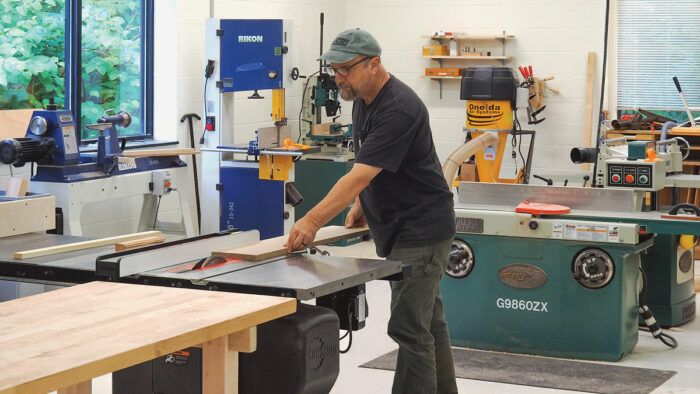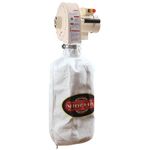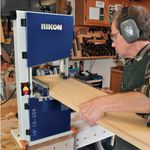How to set up big woodworking machines
Whether you are acquiring a new table saw, a jointer, a lathe, or some other machine, it helps to use best practices from the moment it arrives in your shop.
Synopsis: We’ve all read the tales of craftspeople who create intricate furniture on a small bench with just a few hand tools, and that’s amazing. But in the lives of most woodworkers, the day eventually comes when they purchase a piece of big machinery. Whether you are acquiring a new table saw, a jointer, a lathe, or some other machine, it helps to use best practices from the moment it arrives in your shop. Here are some tips we gathered when setting up Fine Woodworking’s new shop.
Whether it’s taking delivery of your first cabinet saw, upgrading to a bigger planer, or splurging for that floor-standing drill press—or all three—many of us can identify with the joy of getting a big power tool. There’s just one huge, heavy, potentially hernia-inducing hill to climb before you get to enjoy your new acquisition: actually moving the thing into place. Because with bigger tools often comes bigger strain.

While I can’t help you pick up and move the tool, I can give you tips that will make it easier. (Sometimes the tips involve getting help from a buddy.) The folks at Fine Woodworking recently got their new shop off the ground, which meant uncrating, locating, and setting up several large machines. It was a great opportunity to document some of my best practices. The days were long, but thanks to thinking ahead, we knocked out the work quickly and without injury. Whether you’re acquiring one new tool or several, this article will help you manage as well as we did.
|
Ready the space
The new machine will need a place to go. Depending on your shop, this could mean a few things. If you’re replacing a tool with a similar one, you may simply swap one for the other. If you’re getting an entirely new machine, you’ll need to figure out where to place it. Either way, determine the location before the machine arrives and make a path to it. Most likely, the machine will come in a box or crate, so make the path big enough for the whole package. You may be able to get the crate dimensions from the manufacturer or shipper. If there’s already a tool in that spot, get it out of the way as soon as you can.
If you’re getting more than one machine or adding one that will lead to you reorganizing your shop, I recommend mapping out the space. This was crucial in the FWW shop, where we used paper drawings to approximate a scaled layout, and then labeled the locations with masking tape. The tape may seem like overkill, but consider it future-proofing the plan when you have multiple 1,000-lb. crates to move.
If you’re getting more than one machine or adding one that will lead to you reorganizing your shop, I recommend mapping out the space. This was crucial in the FWW shop, where we used paper drawings to approximate a scaled layout, and then labeled the locations with masking tape. The tape may seem like overkill, but consider it future-proofing the plan when you have multiple 1,000-lb. crates to move.
Unpacking   |
Get it close
Speaking of moving, one of my biggest tips is to get the crate as close as possible to the machine’s final home before unpacking it. With heavy components like cast-iron tables and big motors, the fewer times you have to pick up and put down the pieces, the better. Plus, a square crate may be easier to move around than a bunch of loose components. If you can, ask the delivery person to place it right where you want it. This will spare your back, and the delivery person will likely be better equipped to haul heavy machinery anyway.
If you do have to move the crate, fingers crossed you have a pallet jack, or access to one. You can rent one, but the jacks themselves are heavy and awkward to move, so be prepared if you need to pick it up, bring it home, and return it yourself. The more you have to move, though, the more worthwhile the pallet jack will be.
Another option is using black iron pipe as rollers. This old technique is certainly slower, but it works great in a pinch. To get the crate onto the rollers, I recommend a long pipe as a stout lever.
If you wind up having to move a machine yourself without a pallet jack, consider unpacking the crate and carrying the parts to their final location. It’s not my first choice, but it’s a one-time hassle. Please though, lift with your knees.
– Chris Reid and his wife run Reid Studios, a woodworking and ceramics business based in Southbury, Conn.
 For more photos and details, click on the “View PDF” button below:
For more photos and details, click on the “View PDF” button below:
Fine Woodworking Recommended Products

Shop Fox W1826

Rikon 10-3061 10-in. Deluxe Bandsaw
The saw has two speeds: 3,280 sfpm (surface feet per minute) for wood and 1,515 sfpm for soft metals and some plastics.

Veritas Precision Square
 Start with a plan
Start with a plan
























Log in or create an account to post a comment.
Sign up Log in